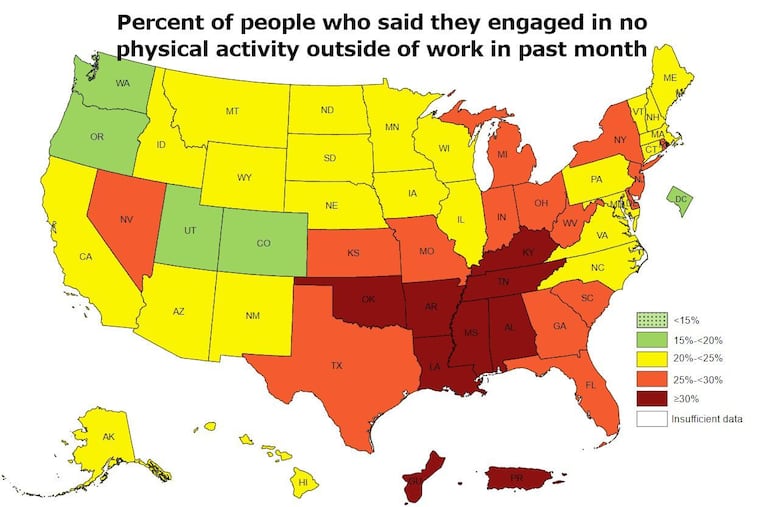These states are the least physically active, new CDC report says. Where do Pa. and N.J. fall?
New Jersey's rate of physical inactivity is second-worst on a scale of one to five.

Folks in the Garden State could stand to do a bit more gardening, apparently.
Or any kind of physical activity at all.
That’s the message from a new federal report with state-by-state estimates of how many people had engaged in no physical activity or exercise outside of work during the previous month.
In New Jersey, that figure was 28.7%, placing it in the second-worst category out of five, the U.S. Centers for Disease Control and Prevention said. Pennsylvania was not much better, at 24.8%, earning it a spot in the third-worst category.
The CDC figures are drawn from a national survey that asked, “During the past month, other than your regular job, did you participate in any physical activities or exercises such as running, calisthenics, golf, gardening, or walking for exercise?”
By region, the South had the highest prevalence of physical inactivity, at 28%, followed by the Northeast (25.6%), Midwest (25%), and West (20.5%).
Coloradans reported the lowest rate of inactivity, at 17.3%. Worst was Puerto Rico, at 47.7%.
The numbers were culled from survey responses from 2015 through 2018. Nationwide, the level of inactivity has remained fairly stable over the last decade, agency officials said.
But the new analysis revealed stark differences among racial and ethnic groups.
Hispanics had the highest rate of self-reported inactivity, at 31.7%, followed by non-Hispanic blacks at 30.3% and non-Hispanic whites at 23.4%.
The CDC’s summary tables do not include socioeconomic factors that might explain that disparity, such as income or job status.
(Could it be partly that the survey question gave golf as one of the few examples of activity? And that word calisthenics — what is this, 1954?)
By any measure, the numbers are cause for alarm, said Ruth Petersen, director of the CDC’s division of nutrition, physical activity, and obesity.
“Too many adults are inactive, and they may not know how much it affects their health,” she said in a statement.
How to explain New Jersey? It is the most densely populated state in the country, along with more than its share of cars, traffic, and lengthy commutes.
On the other hand, it has easier access to gyms than Pennsylvania, where some rural areas are said to have exercise “deserts.”
Whatever the reason, it is no joke. Being physically active is associated with a lower risk of heart disease, type 2 diabetes, obesity, and some cancers, just to name a few benefits.
Inactivity is thought to play a role in one out of 10 premature deaths in the United States.